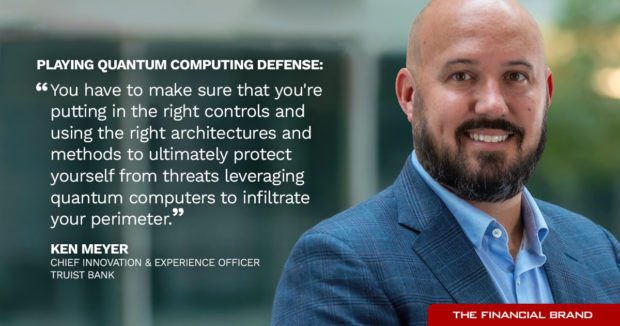Truist and IBM are teaming up to explore applications for quantum computing.
IBM is joining the bank’s Innovation and Technology Center as one of three “innovator in residence” partners. And Truist is joining the IBM Quantum Accelerator program to help the bank prepare for this futuristic technology.
Truist will gain access to IBM’s quantum computing resources and IBM will help it explore possible use cases. Broad areas of research include payment technology, cybersecurity, operational resiliency, artificial intelligence, automation, and transformation of business processes and operations.
An IBM white paper hints at more specific directions the work could go in, suggesting that the demand for greater personalization in providing banking services could be met using the power of quantum computing.
The arrangement with IBM expands the scope of Truist’s innovation center, which opened in June 2022. Quantum computing was one of the key technologies slated for research at the center from the start.
Want to go deep on AI best practices for banks?
Attend our AI Masterclass — Unlocking the Power of Artificial Intelligence in Banking — at The Financial Brand Forum 2024 on May 20-22 in Las Vegas. Led by Ron Shevlin, chief research officer at Cornerstone, this three-hour workshop will be jam-packed with lessons learned from industry leaders and real-world case studies.
For more information and to register, check out the Forum website.
However, to say that quantum computing is leading-edge stuff is more than an understatement.
If you wanted to count the number of quantum computers that IBM owns and operates worldwide, the tally would not require much more than your fingers and toes. Quantum computers won’t be available even to major corporations — much less at Best Buy — anytime soon. At present you can’t even buy one from IBM if you wanted to.

Send the Right Offers to the Right Consumers
Achieve a better return on your marketing investment. Leverage behavioral data and analytics to target the right customers with the best possible offers.
Read More about Send the Right Offers to the Right Consumers

The Financial Brand Forum Kicks Off May 20th
Explore the big ideas, new innovations and latest trends reshaping banking at The Financial Brand Forum. Will you be there? Don't get left behind.
Read More about The Financial Brand Forum Kicks Off May 20th
Why Quantum Computing Matters to Today’s Banks
Quantum computers function at the atomic level, relying on subatomic particles to perform computations. They generate high levels of heat when working, which is part of why only specialists currently have them. The basic unit of quantum computing is the “qubit,” which is, for this technology, the equivalent of classical computing’s “bit.”
Quantum computers can be used to solve extremely complex problems unimaginably fast, even though the science is relatively young.
“Any task where you require really focused speed in order to execute, those are the areas that are traditionally talked about,” says Ken Meyer, chief information and experience officer at the $564.8 billion-asset Truist.

The key part of a quantum computer is quite small, but to function properly that component must be kept very cold. The huge golden mechanism seen here is a “dilution refrigerator,” which provides the cold.
But speed isn’t the sole purpose. It’s speed for a purpose. For example, such speed “has the potential to improve the accuracy of machine learning models by finding different types of relationships in data” than classic computers are capable of, says IBM’s Noelle Ibrahim. “That’s because it is fundamentally leveraging a different type of mathematical structure.”
Quantum computing isn’t going to help process loans faster anytime soon, but it can speed up machine learning for credit default prediction, for example. With quantum computing, many more complex relationships between different datapoints can be evaluated simultaneously, says Ibrahim, associate partner and industry consultant in quantum computing for banking and financial markets at IBM.
Ibrahim notes that IBM recently did some work for a major nonbank financial company testing creditworthiness predictions using a standard database relied on for testing such software. So competitors of traditional financial institutions are already exploring how to make the most of quantum computing as well.

A portion of the Truist Innovation and Technology Center in Charlotte, N.C. The innovation lab opened in mid-2022 and was converted from a huge unused trading floor.
Even though quantum computing isn’t a today or tomorrow tool, Meyer says an institution like Truist can’t just wait. He points to the rapid growth in applications in banking for generative artificial intelligence, notably ChatGPT.
“Nothing has moved faster than generative AI in the history of technology, frankly,” Meyer says. “So you don’t want to sit back and say with quantum computing, ‘Oh, that’s on a five-year window. I’ll worry about it three years from now, four years from now, and I’m sure we’ll be fine.'”
Read more: Truist Plays ‘Long Game’ with Gamified Mobile App to Boost Deposits
Truist-IBM Deal to Help with Cybersecurity Defense
Meyer says that putting staff from both companies into each other’s programs will help address quantum computing “on offense” and “on defense.”
From an offensive perspective, Truist wants to understand how the developing science of quantum computing can be applied. Meyer says this should include potential solutions that nonfinancial players have explored, not just what other banks might have tried.
As for the defensive element, that should be taken literally. Others will have quantum computing resources in the future — which could render the encryption that currently protects many aspects of financial services useless.
“You have to make sure that you’re putting in the right controls and using the right architectures and methods to ultimately protect yourself from threats leveraging quantum computers to infiltrate your perimeter,” says Meyer.
That’s not conjecture. Back in the 1990s, Peter Shor, a noted quantum computer expert, demonstrated algorithms that could be used to crack two common types of encryption. Schor is currently professor of applied mathematics at Massachusetts Institute of Technology.
Access for Truist to IBM’s quantum computers will be provided through the cloud. This is generally how clients and partners try out this technology today, according to Ibrahim.
Meyer notes that it wasn’t so long ago that cloud computing was coming “someday” and now it is a standard tool for most of the world’s large financial institutions.
Read about innovation labs at other banking institutions:
- How U.S. Bank’s Innovators Peer into the Future for Ideas to Incubate
- This Community Bank Innovation Lab Picks Its Battles — and Wins
- How American Express Digital Labs Creates Payments Innovations

Easing into the Nitty-Gritty of Quantum Computing
The early days of the two-way collaboration between Truist and IBM will focus on a two-step process. First, bank representatives will brainstorm ideas for applying quantum technology at Truist. Then the ideas will be prioritized.
“Which use cases should they invest in first? Which are more likely to yield business value sooner?” Ibrahim asks. “And which will continue to provide advantages as the technology matures?”
Much of the learning process will involve developing an understanding of what needs can best be served with the power of quantum computing, she says.
A misconception Ibrahim sometimes runs into is the assumption that quantum computing’s speed should be applied to everything. “That’s not always the case,” she says.
The key issue is the structure of the data being dealt with. “A lot of simple operations on a ton of data” — using mathematical formulas with multiplication and addition, for example — “is not something that a quantum computer is going to yield a lot of advantage for,” says Ibrahim. “Handling complex data structure is what quantum computing is really good at.”
Read more: 3 Strategies for Enterprise AI Success That Are Tried and ‘Truist’








